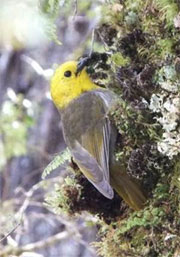|
The Mohua
Introducing the mohua

An adult mohua feeding amongst the moss and lichen on a beech tree (Photo: J. van der Wetering)
Mohua are now absent from 75% of their former range and continue to decline. The biggest cause of their continuing demise is predation by the usual suspects – stoats and rats – especially after beech seeding years when predator numbers erupt and prey on native birds. Mohua are particularly vulnerable as they nest in holes in trees making them easy targets for predators!
Mohua are ranked as Endangered on the world’s Red List of Threatened Species (by the IUCN) and as Nationally Vulnerable on NZ’s own Threat Classification System – both rankings are just 3 steps away from the forever status of Extinction. Despite these rankings, conservation efforts are making a difference and mohua may already be extinct if it wasn’t for two essential conservation tools - predator control and island translocations.
Mohua quick facts
Common Names:
Mohua, Yellowhead, Bush Canary or Yellow-headed fly-catcher
Scientific Name:
Mōhoua ochrocephala
Uniqueness Ranking:
Genus endemic to New Zealand’s South Island
Population Size:
Estimated to number 1,000 - 2,499 mature individuals mainly in Fiordland and Southland/ Otago
Population Trend:
Decreasing
Expected life-span:
expected 5 years in the wild but can live up to 12 years
Size:
15cm; males 30g, females 25g
Breeding:
October – February; 3 eggs/ clutch; female sole incubator
Threatened Species Status:
Endangered (IUCN, 2012) or Nationally Vulnerable (NZ Threat Classification System, 2012). Just three steps away from Extinction!
Taxonomy and relatives
Kingdom Phylum Class Order Family
ANIMALIA CHORDATA AVES PASSERIFORMES ACANTHIZIDAE

Historic painting of the Mōhoua genus in one of New Zealand’s oldest bird texts by Walter Lawry Buller (1888) Birds of New Zealand. The mohua (left), whitehead (top) and browncreeper (right) are illustrated.
The brown creeper (M. novaezelandiae, or pipipi) is ranked as a locally common endemic and is found throughout the forests of the South Island usually in small fast-moving noisy flocks high in the canopy of tall trees.
The whitehead (M. albicilla, or pöpokotea) is considered by some as the North Island version of the mohua, with the main difference being its distinctive white rather than yellow plumage around the head and belly, and it being of a slightly smaller build. Like the brown creeper, the whitehead is also ranked as a locally common endemic. It occurs in native and exotic forest and scrub of the North Island.
History in the making: Mohua were referred to as bush canary by early ornithologists in New Zealand and by many people in the South Island backcountry. Richard Henry, the caretaker of New Zealand’s first Nature Reserve on Resolution Island, referred to mohua as bush canary and in 1901 was summoned by the New Zealand Government to collect specimens of this and other small birds for Museum collections. Mohua later became locally extinct on Resolution Island when stoats made it to the island and Richard Henry had to give up on his conservation dream. But 100 years later a large scale trapping operation by the Department of Conservation has reinstated the island’s sanctuary status and mohua have been successfully returned.
|